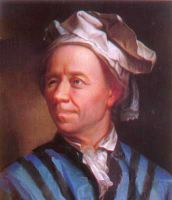

Leonhard Euler went to school in Basel, but the school was a rather poor one, and Euler learnt no mathematics. However his interest in mathematics had been sparked by his father's teaching, and he read mathematics texts on his own and took some private lessons. At age 14, he was sent to the University of Basel to prepare for the ministry. Johann Bernoulli soon discovered Euler's great potential for mathematics.
In 1723, Euler completed his Master's degree in philosophy, and began his study of theology in the autumn of 1723. He could not find enthusiasm for the study of theology, so he obtained his father's consent to change to mathematics after Johann Bernoulli had used his persuasion.
Euler completed his studies at the University of Basel in 1726. He had studied many mathematical works during his time in Basel, including those by Varignon, Descartes, Newton, Galileo, von Schooten, Jacob Bernoulli, Hermann, Taylor and Wallis.
When Nicolaus Bernoulli died, Euler was appointed to his post in St. Petersburg.
Nowhere else could he have been surrounded by such a group of eminent scientists, including Hermann, Daniel Bernoulli, Goldbach, Maier, and Delisle. Euler became professor of physics and a full member of the Academy in 1730. When Daniel Bernoulli left St. Petersburg, it was Euler who was appointed to this senior chair of mathematics.
Euler gained a high reputation, having won the Grand Prize of the Paris Academy in 1738 and 1740. He received an invitation of Frederick the Great to come to Berlin to work at the Academy of Science. Euler undertook an unbelievable amount of work for the Academy.
Hee supervised the observatory and the botanical gardens, selected the personnel, and oversaw various financial matters, and served on various committees.
On top of this his scientific output during this period was phenomenal.
During the 25 years spent in Berlin, Euler wrote around 380 articles. He wrote books on the calculus of variations, the calculation of planetary orbits, artillery and ballistics, analysis, shipbuilding and navigation, the motion of the moon, and differential calculus.
In 1759, Euler assumed the leadership of the Berlin Academy.
In 1766, he returned to St Petersburg. Soon after his return to Russia, Euler was blinded by an illness. Because of his remarkable memory was able to continue with his work on optics, algebra, and lunar motion. After his return to St Petersburg, he produced almost half his total works. His last words were "I am dying".
Euler was the most prolific writer of mathematics of all time. After his death, the St. Petersburg Academy continued to publish Euler's unpublished work for nearly 50 more years.
In number theory, he worked on Fermat primes, and in so doing introduced the Euler phi function. Euler also proved Fermat's Last Theorem for the case of n = 3, and his work led to the introduction of the concept of a ring. Perhaps the result that brought Euler the most fame in his young days was his solution of what had become known as the Basel problem, finding a
closed form for the sum of 1/n2. In the process of doing so he proved connections between the zeta function and the sequence of prime numbers, and the sequence of Bernoulli numbers.
In analysis, Euler first made the notion of a function precise, and did thorough studies of substitutions in differentiation and integrals which can be expressed in terms of elementary functions. He also studied beta and gamma functions, which he had introduced first in 1729, and ordinary and partial differential equations. He also made fundamental discoveries in calculus of variations. His work published in 1740 began the proper study of the calculus of variations.
In complex analysis, he discoved "Euler's Formula" eix = cos x + i sin x, he proved ln(-1) = pi i, he studied orthogonal trajectories, and he rediscovered the Cauchy-Riemann equations.
Other work done by Euler on infinite series included the introduction of his famous Euler's constant. He calculated the constant to 16 decimal places. Euler also studied Fourier series, and he was the first to express an algebraic function by such a series. He found the Euler-Maclaurin summation formula independently of Maclaurin.
Problems in mathematical physics had led Euler to a wide study of differential equations. He considered linear equations with constant coefficients, second order differential equations with variable coefficients, power series solutions of differential equations, a method of variation of constants, integrating factors, a method of approximating solutions, and many others. When considering vibrating membranes, Euler was led to the Bessel equation which he solved by
introducing Bessel functions.
Euler made substantial contributions to differential geometry, investigating the theory of surfaces and curvature of surfaces. Many unpublished results by
Euler in this area were rediscovered by Gauss. Other geometric investigations led him to fundamental ideas in topology such as the Euler characteristic of a polyhedron.
In 1736, Euler published Mechanica, a major advance in mechanics. It was followed by another important work in rational mechanics, developing the kinematics and dynamics of rigid bodies, with the application of ship propulsion. Euler's work on fluid mechanics is also quite remarkable. He published a number of major pieces of work through the 1750's setting up the main formulas for the topic, the continuity equation, the Laplace velocity potential equation, and the Euler equations for the motion of an inviscid incompressible fluid.
Euler contributed to knowledge in many other areas. He did important work in
astronomy, the theory of music, and cartography. We owe to Euler the notations f(x), e, i, the greek letter π, the summation symbol Σ, and many more.